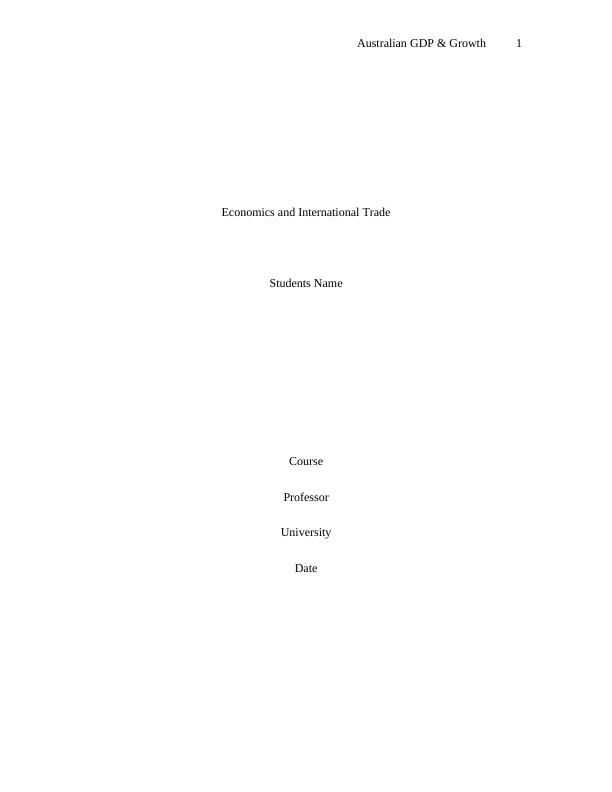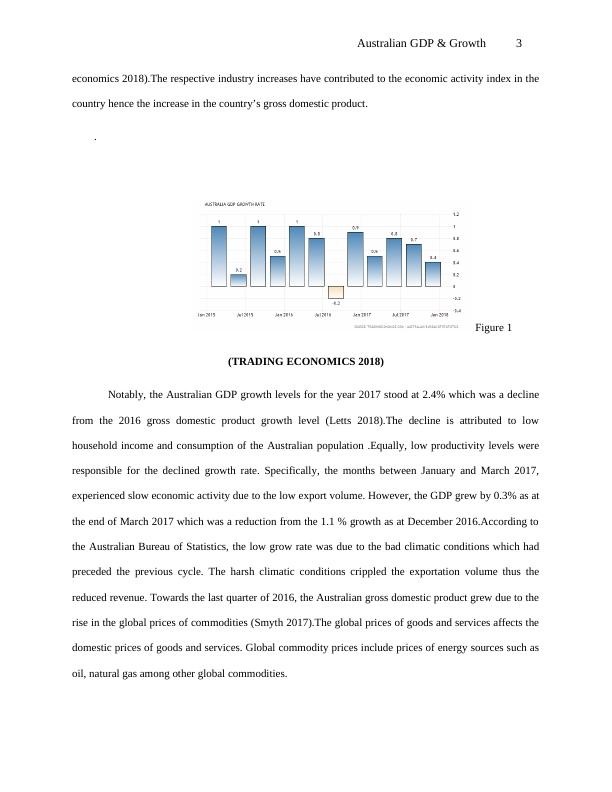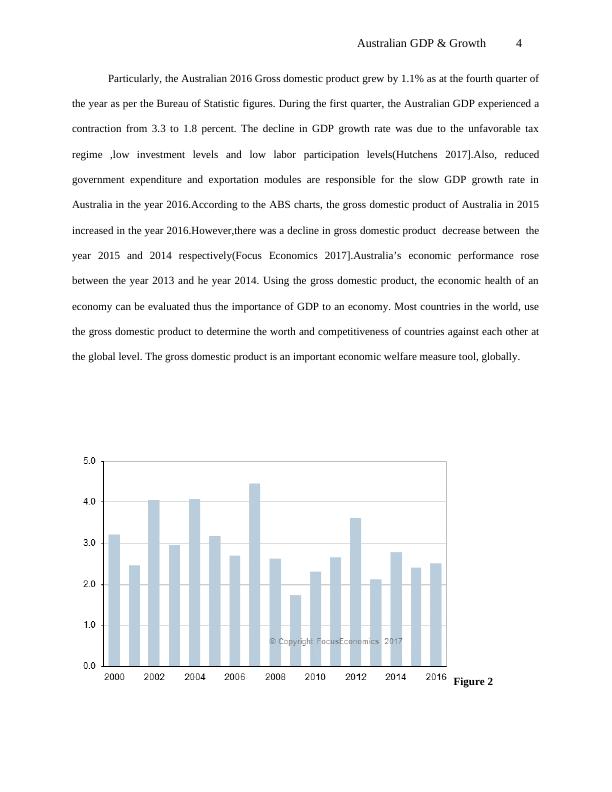Australian GDP & Growth Assignment (pdf)
Added on 2021-06-17
15 Pages3791 Words57 Views
Australian GDP & Growth 1
Economics and International Trade
Students Name
Course
Professor
University
Date
Economics and International Trade
Students Name
Course
Professor
University
Date

Australian GDP & Growth 2
INTRODUCTION
Primarily, the gross domestic product of any country implies the value of commodities and
services provided by a given country over a period of time. Usually the period is one year .Over the years,
the Australian gross domestic product has experienced some changes. The Australian economic
significance to the global economy cannot be ignored. The GDP of the Australian state has slowly but
steadily over the years. The growth of economic activity has made some industries grow such as the
agriculture, mining and services sectors which have greatly contributed to the GDP growth
rate .Majorly ,the reasons for some of the industry’s growth has been due to increase in commodity
prices, labor market flexibility, increased demand and newer markets for the produce. The Australian
economic policies have been put in place to support and sustain economic growth in the country.
Essentially, the Australian government has implemented monetary and fiscal measures to boost its
economic activity which in turn translates into economic activity. Fiscal policies such as taxation
incentives have been implemented to encourage investment in both private and public Australian sectors
of the economy.
GDP AND ECONOMIC GROWTH, AUSTRALIA
Noteworthy, the Australian gross domestic product grew by 0.4 % below market forecasts. The
Dec 2017, quarterly update shows a decline in the GDP growth rate from 2016 September Quarterly
performance. The decline in growth is attributed to consumption spending and construction sectors of the
economy .Particularly, the Australian economy gross domestic product growth rate is averaged at 0.85 %
between the year 1959 and 2017 having reached a 4.4% high note in 1976 and 2% low note in 1974.The
slow pace of economic growth is attributed to the reduced exportation volume of goods which went down
by 1.8% and reduced private investment levels by 2.2%.However,there was substantial increases in
various sectors of the Australian economy which contributed to the slight gross domestic product growth
index. Specifically, in the year 2017-18, public sector investment s rose by 2.9%, importation of goods
and services rose by 0.5%, mining by 1.3% and the construction sector by 0.3%respectively (Trading
INTRODUCTION
Primarily, the gross domestic product of any country implies the value of commodities and
services provided by a given country over a period of time. Usually the period is one year .Over the years,
the Australian gross domestic product has experienced some changes. The Australian economic
significance to the global economy cannot be ignored. The GDP of the Australian state has slowly but
steadily over the years. The growth of economic activity has made some industries grow such as the
agriculture, mining and services sectors which have greatly contributed to the GDP growth
rate .Majorly ,the reasons for some of the industry’s growth has been due to increase in commodity
prices, labor market flexibility, increased demand and newer markets for the produce. The Australian
economic policies have been put in place to support and sustain economic growth in the country.
Essentially, the Australian government has implemented monetary and fiscal measures to boost its
economic activity which in turn translates into economic activity. Fiscal policies such as taxation
incentives have been implemented to encourage investment in both private and public Australian sectors
of the economy.
GDP AND ECONOMIC GROWTH, AUSTRALIA
Noteworthy, the Australian gross domestic product grew by 0.4 % below market forecasts. The
Dec 2017, quarterly update shows a decline in the GDP growth rate from 2016 September Quarterly
performance. The decline in growth is attributed to consumption spending and construction sectors of the
economy .Particularly, the Australian economy gross domestic product growth rate is averaged at 0.85 %
between the year 1959 and 2017 having reached a 4.4% high note in 1976 and 2% low note in 1974.The
slow pace of economic growth is attributed to the reduced exportation volume of goods which went down
by 1.8% and reduced private investment levels by 2.2%.However,there was substantial increases in
various sectors of the Australian economy which contributed to the slight gross domestic product growth
index. Specifically, in the year 2017-18, public sector investment s rose by 2.9%, importation of goods
and services rose by 0.5%, mining by 1.3% and the construction sector by 0.3%respectively (Trading

Australian GDP & Growth 3
economics 2018).The respective industry increases have contributed to the economic activity index in the
country hence the increase in the country’s gross domestic product.
.
Figure 1
(TRADING ECONOMICS 2018)
Notably, the Australian GDP growth levels for the year 2017 stood at 2.4% which was a decline
from the 2016 gross domestic product growth level (Letts 2018).The decline is attributed to low
household income and consumption of the Australian population .Equally, low productivity levels were
responsible for the declined growth rate. Specifically, the months between January and March 2017,
experienced slow economic activity due to the low export volume. However, the GDP grew by 0.3% as at
the end of March 2017 which was a reduction from the 1.1 % growth as at December 2016.According to
the Australian Bureau of Statistics, the low grow rate was due to the bad climatic conditions which had
preceded the previous cycle. The harsh climatic conditions crippled the exportation volume thus the
reduced revenue. Towards the last quarter of 2016, the Australian gross domestic product grew due to the
rise in the global prices of commodities (Smyth 2017).The global prices of goods and services affects the
domestic prices of goods and services. Global commodity prices include prices of energy sources such as
oil, natural gas among other global commodities.
economics 2018).The respective industry increases have contributed to the economic activity index in the
country hence the increase in the country’s gross domestic product.
.
Figure 1
(TRADING ECONOMICS 2018)
Notably, the Australian GDP growth levels for the year 2017 stood at 2.4% which was a decline
from the 2016 gross domestic product growth level (Letts 2018).The decline is attributed to low
household income and consumption of the Australian population .Equally, low productivity levels were
responsible for the declined growth rate. Specifically, the months between January and March 2017,
experienced slow economic activity due to the low export volume. However, the GDP grew by 0.3% as at
the end of March 2017 which was a reduction from the 1.1 % growth as at December 2016.According to
the Australian Bureau of Statistics, the low grow rate was due to the bad climatic conditions which had
preceded the previous cycle. The harsh climatic conditions crippled the exportation volume thus the
reduced revenue. Towards the last quarter of 2016, the Australian gross domestic product grew due to the
rise in the global prices of commodities (Smyth 2017).The global prices of goods and services affects the
domestic prices of goods and services. Global commodity prices include prices of energy sources such as
oil, natural gas among other global commodities.

Australian GDP & Growth 4
Particularly, the Australian 2016 Gross domestic product grew by 1.1% as at the fourth quarter of
the year as per the Bureau of Statistic figures. During the first quarter, the Australian GDP experienced a
contraction from 3.3 to 1.8 percent. The decline in GDP growth rate was due to the unfavorable tax
regime ,low investment levels and low labor participation levels(Hutchens 2017].Also, reduced
government expenditure and exportation modules are responsible for the slow GDP growth rate in
Australia in the year 2016.According to the ABS charts, the gross domestic product of Australia in 2015
increased in the year 2016.However,there was a decline in gross domestic product decrease between the
year 2015 and 2014 respectively(Focus Economics 2017].Australia’s economic performance rose
between the year 2013 and he year 2014. Using the gross domestic product, the economic health of an
economy can be evaluated thus the importance of GDP to an economy. Most countries in the world, use
the gross domestic product to determine the worth and competitiveness of countries against each other at
the global level. The gross domestic product is an important economic welfare measure tool, globally.
Figure 2
Particularly, the Australian 2016 Gross domestic product grew by 1.1% as at the fourth quarter of
the year as per the Bureau of Statistic figures. During the first quarter, the Australian GDP experienced a
contraction from 3.3 to 1.8 percent. The decline in GDP growth rate was due to the unfavorable tax
regime ,low investment levels and low labor participation levels(Hutchens 2017].Also, reduced
government expenditure and exportation modules are responsible for the slow GDP growth rate in
Australia in the year 2016.According to the ABS charts, the gross domestic product of Australia in 2015
increased in the year 2016.However,there was a decline in gross domestic product decrease between the
year 2015 and 2014 respectively(Focus Economics 2017].Australia’s economic performance rose
between the year 2013 and he year 2014. Using the gross domestic product, the economic health of an
economy can be evaluated thus the importance of GDP to an economy. Most countries in the world, use
the gross domestic product to determine the worth and competitiveness of countries against each other at
the global level. The gross domestic product is an important economic welfare measure tool, globally.
Figure 2

End of preview
Want to access all the pages? Upload your documents or become a member.
Related Documents
Australia's Growth Rates and Challenges in Enhancing Themlg...
|12
|2919
|328
Assignments | Macroeconomicslg...
|8
|1492
|63
South Korea Economy: Growth, Inflation, and Unemploymentlg...
|4
|714
|84
(pdf) Sample Assignment on Economicslg...
|15
|3510
|31
Foreign Investment in Australia on Economic PDFlg...
|21
|4053
|448
ECON1005 - Assignment On The Australian Economylg...
|13
|2713
|38